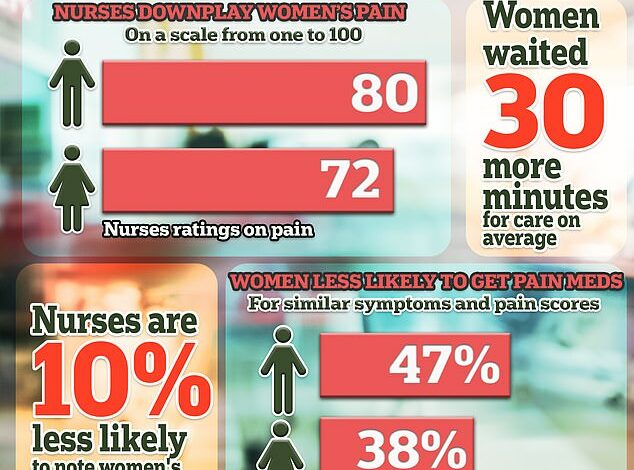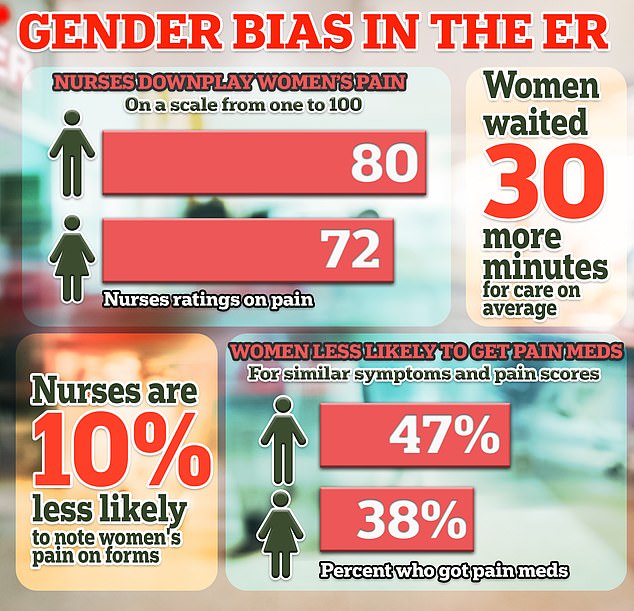Women are less likely to receive appropriate treatment in the ER because they are seen as ‘hysterical and exaggerating’



New research shows that women who present to the emergency department with pain are less likely than men to receive the medications they need to treat their pain.
An analysis of discharge letters from more than 21,000 patients in Missouri and Israel found that female patients were less likely to be prescribed painkillers and more likely to have their symptoms ignored.
Dr. Alex Gileles-Hillel, co-author and a physician at Hadassah-Hebrew University Medical Center in Jerusalem, said: “Women are seen as exaggerating or hysterical, while men are seen as more stoic when complaining about pain.”
It is the latest evidence of sex discrimination in medicine: women are less likely to be treated for heart attacks than men.

Doctors challenge sex discrimination in medicine by presenting both male and female nurses with identical fictional stories about a male and female patient with severe back pain.
When nurses were asked to assign a pain control score to male and female patients with exactly the same complaint and medical history, they perceived female patients’ pain as less intense and less worthy of treatment.
Pain is subjective and doctors and nurses rely on patients to rate their pain on a scale of one to ten, with ten being unbearable.
Medical professionals decide whether to prescribe painkillers and how strong they should be based on what patients tell them.
The latest research published in the Proceedings of the National Academy of Sciences reported that women, even when they rated their pain high on the scale, were nearly 20 percent less likely to use painkillers than men, even when they gave the same self-ratings of pain.
The doctors used notes describing the patients’ treatment when they left the hospital, which showed that 38 percent of them received some form of pain relief, compared with 47 percent of male patients with similar symptoms.
Women generally scored their pain slightly lower than men: 6.64 versus 6.81.
But researchers took this into account and found a similar divergent pattern across all pain ratings.
Further research found that nurses were 10 percent less likely to record women’s pain scores, increasing the likelihood that women did not receive the care they needed.

Women are often not taken seriously when they complain about health problems such as chest pain, increasing their risk of developing a preventable condition or dying.
On average, women had to wait 30 minutes longer for a nurse or doctor in the emergency department, compared to men, who spent less time in the waiting room.
To further test their hypothesis — that there is gender bias in the ED — the researchers gave brief written descriptions of patients to 109 nurses at a Missouri hospital to rate the intensity of the patients’ pain.
The written scenarios for a male patient and a female patient were exactly the same. The only difference was the gender of the fictional patient: ‘Ms. [Mr.] Jones reports to the Emergency Department.
‘She [he] is a 44 year old woman [male]previously healthy. She [he] is suffering from a sharp, throbbing back pain that started gradually the day before.
‘She [he] judges her [his] pain like 9 out of 10 and says it bothers her [his] function. Mrs. [Mr.] Jones reportedly has not tried anything to relieve the pain, is otherwise healthy and is not currently taking any other medications.
Each nurse was then asked to rate her perception of pain on a scale of one to one hundred (maximum pain).
When the nurse was shown a man’s story, they gave his pain a score of about 90, with an average of 80.
But when presented with a nurse describing a woman, the average pain rating was 72. The difference persisted regardless of whether the nurse was male or female.
Researchers called the gap a symptom of the fact that women’s pain is generally “overlooked,” which has “concerning societal and medical implications.”
Women who go to a doctor for pain are generally taken less seriously than men. This is because women have been portrayed for centuries as more emotional and dramatic than men and as more likely to exaggerate their pain.
A 2009 study in the Journal of Women’s Health found that women twice as likely just like men who were diagnosed with mental health problems when they went to the doctor with symptoms of heart disease.
Swedish researchers said in 2018: ‘Women in pain are often seen as hysterical, emotional, complaining, not wanting to get better, faking and making up the pain, as if it is all in their head.
‘Other studies have shown that women with chronic pain are more likely to identify psychological rather than somatic causes for their pain.’
The difference in care that women and men receive is most apparent when women present to the emergency department with symptoms of a heart attack.
A 2022 study found that men approximately 22 percent were more likely to see a doctor immediately if they experienced chest pain than women.
Women had to wait 29 percent longer than men to see a doctor, about 11 minutes more. And when someone is in the middle of a heart attack, those 11 minutes can mean the difference between survival and death.




